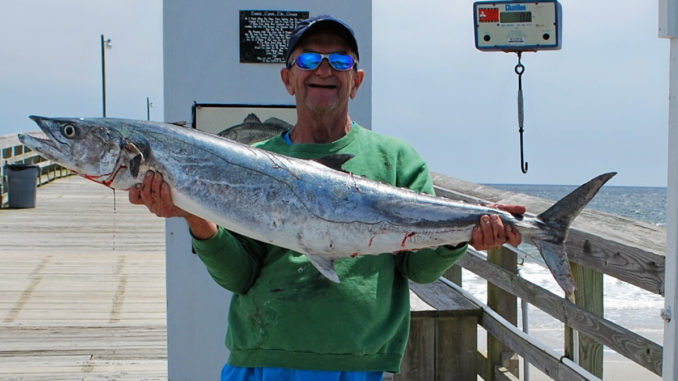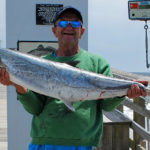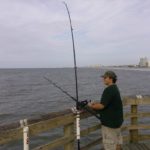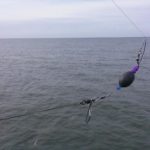
Four piers offer king fishing opportunities.
It’s easy to be fooled by the endless procession of center consoles that go by all spring, summer and fall on US 17. If you happen to witness the start or the weigh-in of a king mackerel tournament, you might think the only way to catch one is to make a long run at high speed in a vessel that costs a king’s ransom. Yet you can fish for these gamefish all along the Grand Strand without leaving the beach, for far less money, by fishing from a pier.
The Grand Strand features four piers that allow live-bait king mackerel fishing from their deep ends – Apache, Surfside, Cherry Grove and Myrtle Beach State Park – and some even hold tournaments. Most have an additional daily fee to fish for kings, but what you will spend is far less than buying your own boat. What’s more, you will get to meet and trade stories with hard-core fishermen, some of whom spend most of their summers on the pier, while waiting for that trophy to strike.
If you are going to get serious about catching a king from a pier, there’s really only one way to do it: the trolley rod system. Mark Sloane of Little River has become a master of the system and has fished all of the king-friendly piers in the area, but he concentrates most of his efforts at Apache Pier and Cherry Grove Pier. Sloane said Apache is the most-consistent producer, but the fishing at Cherry Grove peaks in the fall due to its proximity to Hog Inlet and the bait that gets flushed out on a falling tide.
A trolley rod setup is actually a two- or three-rod system beginning with a heavy, 9- to 12-foot surf outfit spooled with 20-pound line. You use this rod to cast an 8-ounce “nail” sinker – which looks like a grappling hook – as far as you can, then make sure the tines dig into the sand. Most old salts rest this rod in a holder or hold it in place against a pier rail with a bungee cord. This is the line that you “trolley” your live bait down to the water.
The king rod comes next. It is a shorter, medium-action rod paired with a conventional reel. You will see 4/0 Penn Senators and Shimano TLDs on the pier, but whatever you choose, it’s important to have a smooth drag and a ton of line on the reel. A good many pier fishermen have switched to 50-pound braid to give them more line capacity on the reel. The line is tied to a monofilament shock leader, a snap swivel and several feet of 60-pound stranded wire and two or three No. 2 treble hooks. Once the live bait is hooked through the back, a trolley clip – a snap swivel, followed by a float, then an egg sinker and an old-fashioned, wooden clothespin – is snapped onto the trolley line. The clothespin holds the snap swivel on the king rod in place, and the live bait is smoothly lowered onto the surface of the water by paying out line from the king rod, which is lashed to the pier of put in a rod holder. Ideally, the bait will stay right on the surface and frantically swim in circles.
It’s important to use the freshest, friskiest bait possible, and this is where the third rod comes into play. Sloane will use any bait available when he starts a day of king fishing, be it a spot, mullet, menhaden or pinfish, but he says he has had the best success with a live bluefish. He rigs a lighter spinning rod with a Got-Cha plug or a Stingsilver and tries to catch one. When he does, it is immediately deployed. Some piers have community bait tanks to stockpile these precious baits, so use it if it is available.
When a king smashes your bait, it will make a long, fast run that causes the reel to scream. Don’t try to stop the fish; keep the drag light and let the fish tire itself out. If there’s a crowd at the end of the pier, anglers have to work together getting lines cleared to avoid tangles, getting the pier gaff ready, and helping gaff the fish.
It’s a bit harder to catch kings from a pier than a boat, and you probably won’t catch nearly as many. However, you’ll be proud of the ones you do catch, and you can catch a stud, too. Every year, plenty of kings that weigh better than 30 pounds are decked at Grand Strand Piers.
Here are some details on Grand Strand piers that allow king mackerel fishing.
· Cherry Grove Pier, 3500 N. Ocean Blvd., N. Myrtle Beach, 843-249-www.cherrygrovepier.com. Daily rate: $16 for king fishing. Features: community bait tank, observation deck.
· Apache Pier, 9700 Kings Rd., Myrtle Beach, 843-497-6486, www.theapachepier.com. Daily rate: $19 for king fishing. Features: community bait tank.
· Myrtle Beach State Park Fishing Pier, 4401 S. Kings Hwy, Myrtle Beach, 843- 238-5326. Daily rate: $5. Season rate: $125.
· Surfside Pier, 11 N. Ocean Blvd., Surfside Beach, 843-238-0121, www.surfsidepier.com. Daily rate: $12.50 for king fishing.





